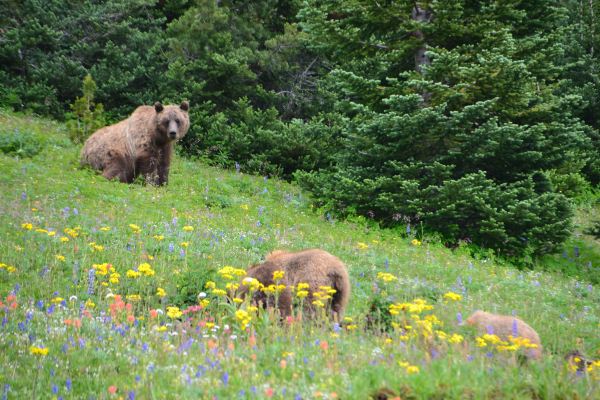Over the last 30 years we have focused our work on the Bridge River Watershed area, with a special focus on the South Chilcotin Mountains, located in the south eastern corner of the Chilcotin Ark. Our planned future research and conservation and stewardship projects in the whole Chilcotin Ark to ensure habitat connectivity and climate change resilience.

Future Research
Mountain Goat Sustainability in Times of Climate Change
This study combines land survey photographs from 1947 and our existing data to understand long-term landscape changes and the impact on habitat suitability. This contributes to enhanced management of mountain goat habitat for the future
Grizzly Migration Pattern Monitoring throughout the Chilcotin Ark
This study will assess where grizzlies range. Knowing migration routes means we can reduce human-wildlife conflicts by knowing where grizzlies will be at certain times of the year and sharing this with the public.
Plant Pollen Analysis of Glaciers
This study is to determine changes in species distribution over time. By assessing the different layers of ice in glaciers, we can learn a lot about the species that lived here over thousands of years.
Predator Impacts on Ungulate Populations and their Effect on Ecosystems
Understanding predator numbers and their impact on prey species will determine population management strategies and determine the carrying capacity of each species.
Impact of Climate Change on Alpine Flowers and Grasses as Food Sources
We want to assess how climate change is impacting the distribution and prevalence of alpine flowers and grasses to determine how this may affect their ability as a food source for mountain goats, mule deer, California Bighorn sheep, black and grizzly bears and moose. This will help us assess what management is needed of these plant species to ensure the wildlife still have enough to eat.
Climate Change Resilience and Adaptation of Wildlife and Ecosystems
Studies have shown that wildlife in flat country move north 10 miles per decade to avoid the affects of climate change, they need only move 36 feet higher in elevation in the same time frame to get the same benefits. For species that already live at the top of the mountains such as mountain goats, we want to assess how this need to move north restricts the area they are able to inhabit, such as competition for resources among mountain goats.
California Bighorn Sheep Collaring Project
We want to understand migration patterns of the Relay Creek herd, how and where the sheep migrate between their summer and winter ranges. This will help us better understand the impact of predators on the herd and winter survival rates.
Impact of Domestic Sheep on Wild Sheep
Domestic sheep are carriers of Bighorn sheep pneumonia complex. When wild and domestic sheep live in close proximity to each other, the wild sheep contract the pneumonia complex from the domestic sheep. Lambs and older sheep are most vulnerable and will die from the disease. Understanding how the disease is spread between the domestic and wild sheep will create management strategies for how to keep the domestic sheep further away.
Heli-Skiing and Heli-Biking Wildlife Displacement
Multiple studies have shown that helicopter close to wildlife habitat displaces wildlife. Mountain goats are particularly vulnerable to this and this is why there is a government regulation that helicopters must not fly closer than 1500m to wildlife and wildlife habitat. We want to assess how failure to observe this regulation is displacing wildlife in the Chilcotin Ark and if this leads to an increase in wildlife mortality. This will be used to influence management of helicopter use in the Chilcotin Ark.
Chilco / Tatlayoko Grizzly Study
This study will take place May 15- June 15 in the Chilco / Tatlayoko area. Every spring, a large number of grizzly bears migrate through the Tatlayoko Valley. We want to better understand their migration patterns to determine species management strategies and reduce the risk of human conflict. This is part of our larger grizzly migration study through the Chilcotin Ark.
Tatlayoko Western Non-Talking Toad Study
Every year, these unique toads come to a specific pond in the Tatlayoko Valley, right at our Tatlayoko Research Station to mate and lay their eggs. The tadpoles live in this pond until they are ready to move away. We want to better understand this behaviour as there are few amphibians in the Chilcotin Ark.